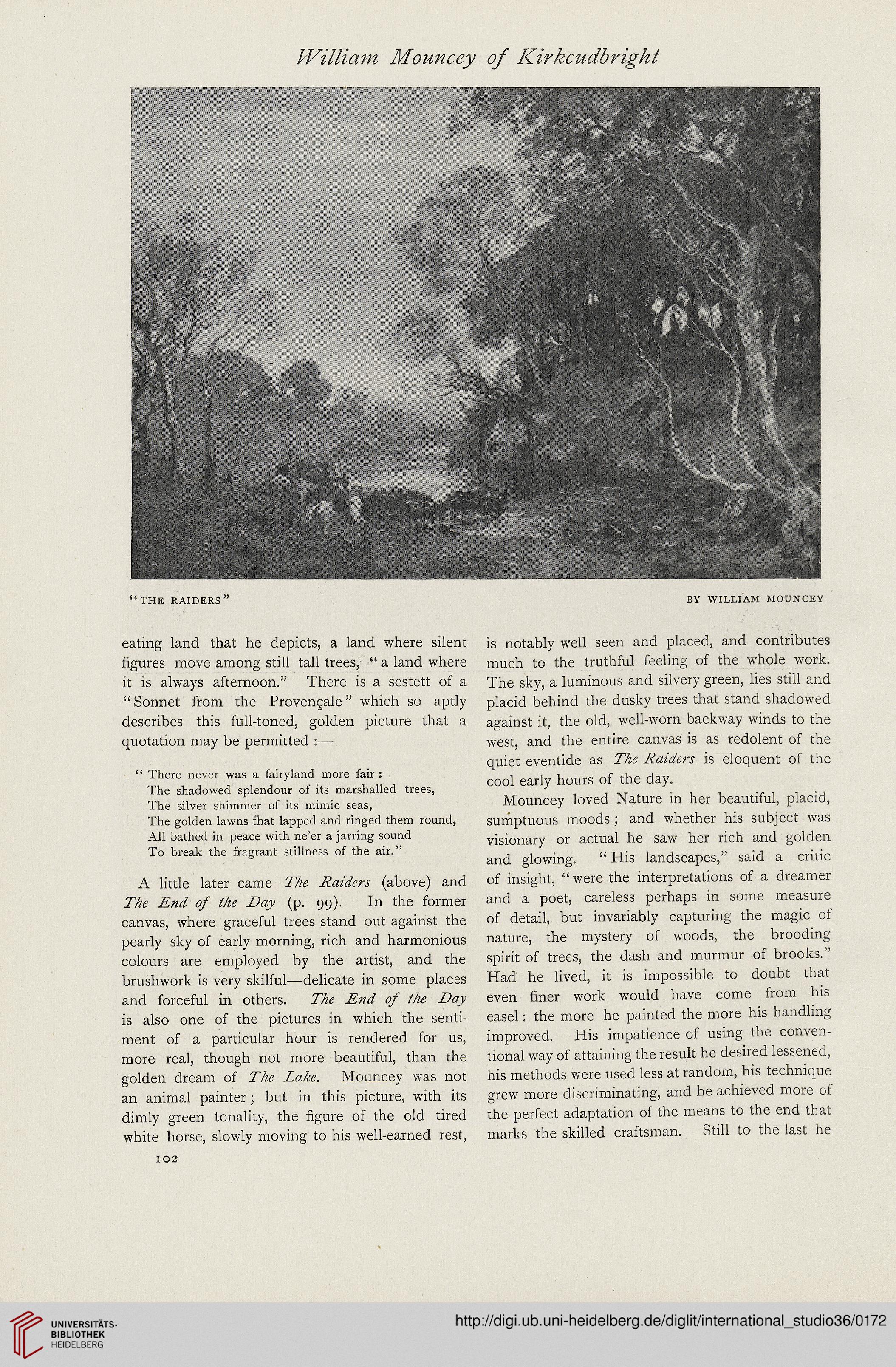77<r/<^^7^/
" 'i'HE RAiDERS" BY WILLIAM MOUNCEY
eating land that he depicts, a iand where silent
hgures move among stiil tall trees, " a iand where
it is always afternoon." There is a sestett of a
"Sonnet from the Provengale" which so aptiy
describes this fuil-toned, golden picture that a
quotation may be permitted
" There never was a fairyland more fair :
The shadowed splendour of its marshalted trees,
The silver shimmer of its mimic seas,
The golden lawns fhat lapped and ringed them round,
AIl bathed in peace with nc'cr a jarring sound
To break the fragrant stillness of the air."
A iittie later came (above) and
.E7M? o/" 7^ -Dtry (p. ^g). In the former
canvas, where graceful trees stand out against the
pearly sky of early morning, rich and harmonious
colours are emptoyed by the artist, and the
brushwork is very skiiful—delicate in some places
and forceful in others. JHc .EW <7/ Zl<ry
is also one of the pictures in which the senti-
ment of a particular hour is rendered for us,
more real, though not more beautiful, than the
golden dream of J/zc Mouncey was not
an animal painter; but in this picture, with its
dimly green tonality, the hgure of the o!d tired
white horse, slowly moving to his well-earned rest,
is notably well seen and placed, and contributes
much to the truthful feeling of the whole work.
The sky, a luminous and silvery green, lies still and
placid behind the dusky trees that stand shadowed
against it, the old, well-worn backway winds to the
west, and the entire canvas is as redolent of the
quiet eventide as A'rMg'cT-.f is eloquent of the
cool early hours of the day.
Mouncey loved Nature in her beautiful, placid,
sumptuous moods; and whether his subject was
visionary or actual he saw her rich and golden
and glowing. " His landscapes," said a critic
of insight, " were the interpretations of a dreamer
and a poet, careless perhaps in some measure
of detail, but invariably capturing the magic of
nature, the mystery of woods, the brooding
spirit of trees, the dash and murmur of brooks."
Had he lived, it is impossible to doubt that
even finer work would have come from his
easel: the more he painted the more his handling
improved. His impatience of using the conven-
tional way of attaining the result he desired lessened,
his methods were used less at random, his technique
grew more discriminating, and he achieved more of
the perfect adaptation of the means to the end that
marks the skilled craftsman. Still to the last he
102
" 'i'HE RAiDERS" BY WILLIAM MOUNCEY
eating land that he depicts, a iand where silent
hgures move among stiil tall trees, " a iand where
it is always afternoon." There is a sestett of a
"Sonnet from the Provengale" which so aptiy
describes this fuil-toned, golden picture that a
quotation may be permitted
" There never was a fairyland more fair :
The shadowed splendour of its marshalted trees,
The silver shimmer of its mimic seas,
The golden lawns fhat lapped and ringed them round,
AIl bathed in peace with nc'cr a jarring sound
To break the fragrant stillness of the air."
A iittie later came (above) and
.E7M? o/" 7^ -Dtry (p. ^g). In the former
canvas, where graceful trees stand out against the
pearly sky of early morning, rich and harmonious
colours are emptoyed by the artist, and the
brushwork is very skiiful—delicate in some places
and forceful in others. JHc .EW <7/ Zl<ry
is also one of the pictures in which the senti-
ment of a particular hour is rendered for us,
more real, though not more beautiful, than the
golden dream of J/zc Mouncey was not
an animal painter; but in this picture, with its
dimly green tonality, the hgure of the o!d tired
white horse, slowly moving to his well-earned rest,
is notably well seen and placed, and contributes
much to the truthful feeling of the whole work.
The sky, a luminous and silvery green, lies still and
placid behind the dusky trees that stand shadowed
against it, the old, well-worn backway winds to the
west, and the entire canvas is as redolent of the
quiet eventide as A'rMg'cT-.f is eloquent of the
cool early hours of the day.
Mouncey loved Nature in her beautiful, placid,
sumptuous moods; and whether his subject was
visionary or actual he saw her rich and golden
and glowing. " His landscapes," said a critic
of insight, " were the interpretations of a dreamer
and a poet, careless perhaps in some measure
of detail, but invariably capturing the magic of
nature, the mystery of woods, the brooding
spirit of trees, the dash and murmur of brooks."
Had he lived, it is impossible to doubt that
even finer work would have come from his
easel: the more he painted the more his handling
improved. His impatience of using the conven-
tional way of attaining the result he desired lessened,
his methods were used less at random, his technique
grew more discriminating, and he achieved more of
the perfect adaptation of the means to the end that
marks the skilled craftsman. Still to the last he
102




